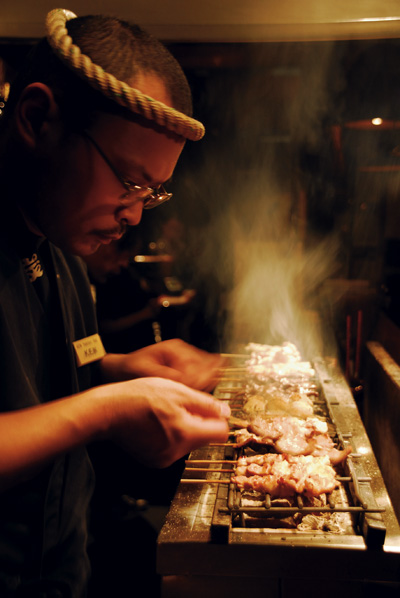Q: What is the difference between BBQ chicken and yakitori?
The difference is this: with Western BBQ chicken we have a few large pieces of chicken meat cooked over a barbeque, often basted with a sauce; with yakitori, small pieces of different cuts of the chicken have been threaded onto small skewers, all of the same size, and these are grilled over charcoal contained in a thin, oblong grill.
 The container is just the right size for a large number of these skewers to sit comfortably right across, from one end to the other. The charcoal adds a distinct, smoky flavour to the meat. All of the skewers must be turned by hand, by the chef, paying close attention to make sure that they are all cooking evenly and well.
The container is just the right size for a large number of these skewers to sit comfortably right across, from one end to the other. The charcoal adds a distinct, smoky flavour to the meat. All of the skewers must be turned by hand, by the chef, paying close attention to make sure that they are all cooking evenly and well.
Yakitori, though undoubtedly Japanese, is part of a tradition of cooking skewered pieces of meat over a grill which originates from the Asian continent, and dates back thousands of years. Turkish shish kebab ultimately derives from the same origin, and Central Asian shashlik cooking looks very similar to the method used for yakitori, except that lamb, rather than chicken, is the meat of choice.
As with other food items, there will be yakitori establishments in Japan that specialise in nothing else. All parts of the chicken are used, from the meat, to the gizzard, to the liver and heart; (though, for NZ tastes, restaurants here will probably stick to just the meat). These can be seasoned differently, either with a dry spice, say, or with a tare sauce (made from a mixture of mirin, shoyu sauce, sake and/or sugar). People will often consume the skewers with no more than a wedge of lemon, or some salt, though.
Carefully chosen vegetables, such as spring onions and green peppers, or herbs like the Japanese shiso leaf, will sometimes be added for variety.

